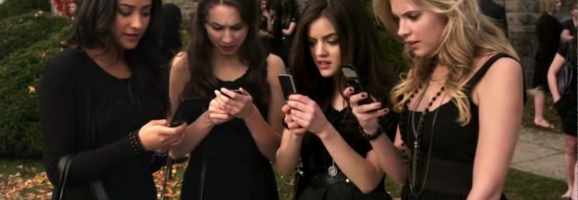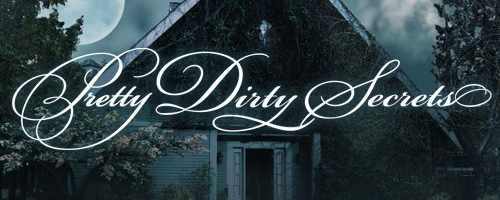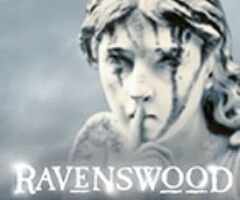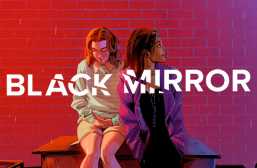The Transmedia Universe of Pretty Little Liars

First released in 2010, Pretty Little Liars has created an explosion of interest from within the television industry. Not only has the program managed to gain constant and ever-growing support form a global fan base, but it has shaken the world through its various media platforms. Although it initially appears to be just another teen drama, the expansive world created in and around the show has allowed for audiences to experience the storyline in a unique and engaging manner.
Following the lives of four Rosewood girls, Pretty Little Liars is initially seen to be exploring the effects of a close friends death on teenage girls. However, when the mysterious “A” begins to torment them, the girls soon find themselves facing a series of chaotic circumstances that leave them questioning the reality of their friend Alison’s death. Essentially, the series revolves around the questions: “Who is A?” “Is Alison dead?” “Who is helping A?” “Why is A doing this?” Of course these questions are periodically answered and then somehow re-asked, but the suspense they carry is what keeps the shows massive fan base coming back for more.
Yes, at times it seems like any old teenage drama, but what makes Pretty Little Liars special is the unique and extensive Transmedia universe built around the program. Transmedia storytelling is the use of various different media platforms to add to and support an original storyline. In the case of Pretty Little Liars, the most monumental platforms used are social media, spin-offs and second screens. Through these means, the creators have been able to develop an entire world around the Pretty Little Liars storyline, allowing viewers to further immerse themselves in the action.
Social Media

Social media plays a vital role in the success and maintenance of this Transmedia brand. An array of social media channels are used to support the storyline including Facebook and Instagram, however the most groundbreaking of their collection is the shows Twitter campaign. Through these means, Pretty Little Liars has been able to directly engage audiences in a personal and accessible manner. Given the target market for the show, social media remains the most effective way to actively involve their audience in the creative process.
One of the many uses for Twitter in this case has been to monitor the popularity of characters, allowing the creators to adapt the program to further please audiences. For example, if a character gains too much negative attention or is deemed boring, the creators move towards removing them from the show or limiting their screen time. This direct communication channel not only gives modern audiences the power they crave, but allows the program to remain in high demand.
In terms of the programs Transmedia campaign, Twitter extends the storyline by voicing the thoughts of characters through their own personal accounts. These accounts are used to give viewers additional (and often revealing) information regarding the mysteries in the show, in addition to humanising the characters themselves.
The most popular of these accounts is that of Mona Vanderwaal, through whom the program was able to launch an online scavenger hunt. This campaign took viewers on a journey though carious social media channels to eventually unlock a 2 minute video that served as Mona’s online diary. This video, not aired anywhere else, gave dedicated viewers the opportunity for inside knowledge and an exclusive preview into Mona’s personal plans.
This aspect of Pretty Little Liars‘ Transmedia campaign has seen an incredible response particularly throughout 2013-14. In fact, the return of season 3 saw Pretty Little Liars-related Tweets accounting for 52% of overall Twitter activity in early 2013! Or (to be more precise) 39,000 tweets per minute and 1.4 million overall mentions on Twitter!
Spin-offs

The first Pretty Little Liars spin-off we have seen was the 8-part webseries release in 2012 by the name of Pretty Dirty Secrets. This extension on the original program allowed for a deeper look into the inner workings of the area and provided viewers with inside information to certain suspicious on goings. It was through this series that the character of Shana was first introduced.
This webseries, although short-lived, proved to be a highly successful and beneficial addition to the Pretty Little Liars Transmedia campaign. Each episode saw between 200 000- 600 000 viewers, with over a million people viewing the entire webseries! This campaign engaged viewers and gave them the additional information they needed to become further engulfed in the storyline.

Perhaps one of the highlights of this Transmedia campaign, though, is the spinoff TV series that runs alongside the drama of Pretty Little Liars, the newly released Ravenswood. Stealing one of the more popular characters of the show, Hannah’s boyfriend Caleb, this show diverges from the original storyline mid-season 3 and follows Caleb’s adventures through the neighboring town of Ravenswood.
Unlike the original program, Ravenswood is what could only be described as a sci-fi teen drama. Although there are key diverging aspects between the two programs, Ravenswood is linked to the original program through Caleb’s returns to Hannah. This spinoff is a unique and highly successful aspect of this Transmedia campaign, successfully corroborating and extending the original storyline yet additionally managing to remain own entity.
Second Screen Viewing
The incorporation of the second screen into the viewing of television programs is a Transmedia trend used within popular programs today. Originally introduced by NBC for their programs Breaking Bad and The Walking Dead, the second screen essentially involves an app designated to run alongside the original program. This app is viewed on a phone, computer or tablet and enhances the viewing experience by allowing the viewer to engage with additional material during viewing.
Pretty Little Liars has made use of this trend, creating an app called “PLL Second Screen Halloween Party” which was linked to Facebook during the airing of their 2013 Halloween special. Throughout the airing, viewers were able to activate the app on their second screens and participate in a range of bonus materials. One of the most popular elements of this app was the exclusive and revealing sneak peek to the show’s winter season.
Although this Transmedia platform has been used in many past programs, Pretty Little Liars was able to make their version unique and groundbreaking. Unlike any application of its type, it opened a direct line of communication between actors and viewers, allowing each second screen user to ask 2 questions to any main actor and have them respond directly. This was the first time ABC had used such means to communication with actors, and the reception proved more than positive.
 Pretty Little Liars has used a Transmedia storytelling campaign to build a strong and interactive relationship with its fan base, allowing them to participate in a unique viewing experience unlike anything else. This program has used a collaboration of social media, spin-off and second screen campaigns to create a community behind the brand and demonstrate the benefits of Transmedia storytelling.
Pretty Little Liars has used a Transmedia storytelling campaign to build a strong and interactive relationship with its fan base, allowing them to participate in a unique viewing experience unlike anything else. This program has used a collaboration of social media, spin-off and second screen campaigns to create a community behind the brand and demonstrate the benefits of Transmedia storytelling.
What do you think? Leave a comment.











Personally, I do not have time sit down and play some type of game in order to feel the ultimate experience. Although it sounds very interesting and one day I’m willing to try it.
I believe that transmedia narratives will be even more popular in the future as many more interesting platforms and technologies will be created. We are heading at the right direction for sure.
Definitely! This is only just the start of commercial transmedia storytelling so it’s incredible to think what kinds of experiences the next generation will get from television!
Intriguing. Transmedia narratives are on the rise. But I don’t think I can bare myself to watch Pretty Little Liars though.
I just love how they get rid of characters in this show. They really need to bring back Noel, Lucas, Wren, and Jason. They were important characters that seems to be forgotten. I miss them a bunch and would love to see them again.
I know ! They seem to have dropped significant aspects of the storyline by losing those characters as well… I’d definitely like to see wren again !
The show is one long red herring. It’s like a chain letter getting passed from one character to another. That’s why I can’t believe people actually bought into the Ezra red herring and now are drawing a line in the sand to intimidate the show into making Ezra A or they’ll quit watching.
I guess a lot of people wanted Ezra to be A so having that become a reality they bought it hook, line and sinker.
At this point everything is a red herring. What you believe to be fact today will be twisted into something new tomorrow.
Like Lost, I believe the show won’t have a satisfying ending.
That’s so true! I also feel that the show incorporates so many twists and turns that it often feels inconsistent with past events. That being said, I haven’t found anything to support the lack of continuity so maybe it’s just really clever writing?
I also don’t think the ending is going to be satisfactory. It’ll be a miracle if it is- with all the hype its made about the mystery
This show is the perfect example for Transmedia narratives and it’s definitely on the rise. With things needing a sense of uniqueness, Pretty Little Liars was able to use the Transmedia to help separate themselves from typical teenage tv. With these forms of narratives, it allows watchers to constantly guess about what is going on. For example, Pretty Little Liars has a hashtag for every night it’s new episode airs and when people see it, they wonder what that about? What show is it for? That brings in more viewers and helps the writers know that they continue stretching the story line because the show continues to grow with popularity. Other shows would do well if they learned from this.
I personally have enjoyed the introduction of Ravenswood to Abc Family, especially in terms of how Pretty Little Liars and Ravenswood have interlaced plots and characters. Although I have not seen a Ravenswood episode yet, Ravenswood has been referred to multiple times in Pretty Little Liars (the scene with Caleb on the bus between Ravenswood and Rosewood is especially telling and subtly descriptive). I don’t think public television has experienced this sort of interlacing in years, and this tactic really puts Abc Family in a smart place–PLL viewers are now Ravenswood viewers (the sentiment is that occurrences in one show will help decode a mystery in the other) and vise versa. I’m excited to see how the shows continue to grow together.
Nice article Nicola, thank you. It seems like a good job of exactly what you call it, “Commercial Transmedia Storytelling.”
I think this DOES represent progress for storytelling and television, so I’m sort of willing to applaud it.
On a more personal note, I don’t like television (I find it a low-value use of time) and I do love The Internet / Online Media (freedom, speech, individual voice)
So for me personally, the “developments” you describe represent the colonization of new media by old media. Technically yes, it is “transmedia.” But for my own flavor of choice “transmedia” isn’t top-down storytelling by the same large corporations and gatekeepers of yore, rather it’s bottom-up story-creating by a network of users generating content.
I realize my view isn’t helpful to Corporate Capitalist Commodity Culture. I also realize that an awful lot of viewers don’t want to “write their own stories” or as we saw in one of the comments you got above, don’t even want to bother with the additional transmedia elements at all.
Undoubtedly transmedia will find the strongest use in corporate marketing (what doesn’t) but that doesn’t make other uses less meaningful. A truly spiritual song sung between a few people will never make the kind of money that a Katy Perry or Justin Bieber record will, but that doesn’t mean it can’t be more spiritual and valuable.
This article is spot on. Pretty Little Liars is great in engaging its audience across a wide variety of platforms, which makes up for its less than stellar ratings.
Great article, Nicola! I’m a sucker for Pretty Little Liars, and have been amazed by the success of its Transmedia storytelling. Admittedly, I have not seen any of the webseries or Ravenswood but have been sucked into the actual show since the beginning. After reading this article, I’m wondering how Transmedia would enhance, or perhaps change, watching Pretty Little Liars on TV. Other TV shows should take note of Transmedia narratives!
I have watched this show from the beginning and it is equal parts entertaining and frustrating. Sometimes the girls can’t figure out incredibly obvious things and questions are left unanswered but then a new threat emerges and more questions arise keeping me instrested.I feel that they do a really good job of using media to keep fans intrested and participating no matter how frustrating or shocking the show can get. Great job on the article.
I’m interested how transmedia will transform entertainment, but I’m not sure whether I will like the results. A poet is not a jukebox.
Did you have to pay for Pretty Dirty Secrets or did it have free access?